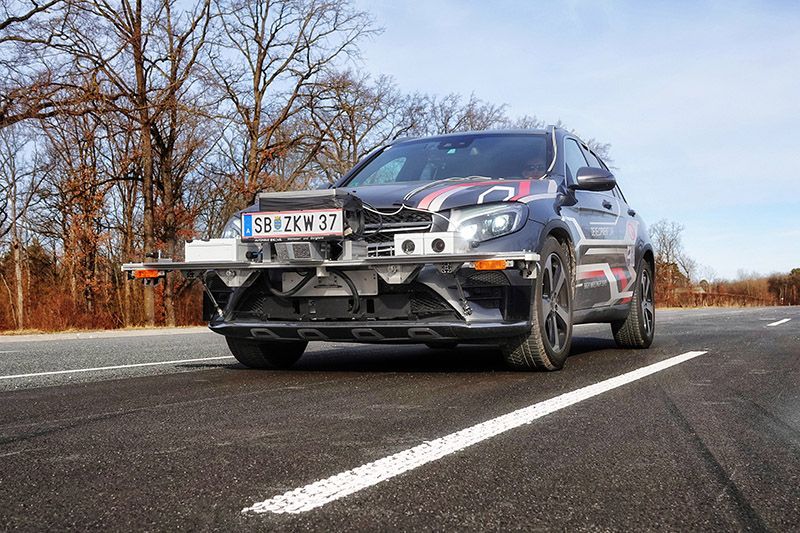Are our Roads ready for Automated Driving?
30 March 2023 – In an interview, US consultant Robert Dingess reports on the extent to which our planet's transport infrastructure is already prepared to pave the way for automated driving. Well-maintained road markings play a key role here.
Mr Dingess, where do we currently stand internationally when it comes to road markings and automated driving?
Robert Dingess: It is increasingly apparent that road markings are the single most important traffic control device in support of vehicle automation. The United States, German, and Japanese governments, are working towards a more harmonized, monitored, and better maintained system of road markings. German and Japanese research efforts are focused on improving simulation modeling by addressing contrast and marking wear, while in the United States, the US Department of Transportation has proposed wider lane marking standards, inclusion of dotted edge lines at exit and entrance ramps and established a minimum retroreflectivity standard to improve highway marking maintenance. Original Equipment Manufacturers (OEM) are trying to use collected sensor data to improve road safety. The Mercedes ROMO project with the Dutch government and General Motors’ Future Roads are examples of private sector initiatives with great potential to improve marking maintenance and roadway safety.
Addressing a better understanding of the requirements placed on road markings. In which parts of the world are standards and specifications for road markings already being pushed forward due to automated driving?
Dingess: If you were to ask government representatives around the world how the respective road network is being prepared for automated driving, you would probably get many different answers. One reason is the legal situation that varies all over the world. Once you leave the realm of SAE Level 2, regulations get confusing. What is clear, however, is that road network reliability and harmonization are key to ensuring that automated systems, whether driver assist or full automation, function safely. For example, a lane-keep system needs to find the edge of the road or lane. What better way to ensure reliable lane edge detection than with well-maintained pavement markings? There is little scientific data to justify changing the roadway specifically to support highly automated systems. Our approach has been to understand the principles of machine vision technologies and propose changes that have already been demonstrated to improve safety for humans.

US consultant Robert Dingess emphasizes the importance of well-maintained road markings for automated driving. Accordingly, SWARCO Road Marking Systems and its partners are conducting targeted research into road marking systems that provide the best possible support for automated driving.
What points do you consider particularly important in these specifications?
Dingess: This is a good question. It is highly dependent on the machine system being used and the activity being automated. The more complex a system is, the further down the road it must be able to see - similar to a human driver. Highly visible markings need to be present to provide system reliability. Markings are required to be uniform, installed, and maintained.
With this in mind, the collected and connected sensor data will probably become more valuable. They could provide important information about the condition of road markings in real time - and thus completely change the way we think about monitoring marking performance and maintenance.
In Europe, the focus was particularly on Germany, which was the first country to grant technical approval to a SAE Level 3 system. In your opinion, which aspects play a key role in Germany's pioneering role?
Dingess: Germany has 900,000 jobs in the automotive industry and the second most extensive motorway network in Europe. No other EU country benefits more from ensuring a robust automotive industry than Germany. It is therefore not surprising that the use of SAE Level 3 technologies on German roads has been made possible. These legal regulations are likely to serve as a benchmark for the EU. It may be too much to ask, but I would like Germany to take a similar leading role when it comes to setting EU standards for road marking quality. China (161,000 km) and the United States (96,000 km) are already improving marking standards to prepare their highway networks for automated driving. Germany must ensure, at a minimum, that the trans-European road network (137,000 km) keeps up with these efforts. Otherwise, it could happen that German manufactured ADAS systems might only perform well in Germany.
A report published by the consulting firm McKinsey has confirmed that automated driving has great potential, but also sees a high level of uncertainty. Looking ahead, how do you see the next few years in this field?
Dingess: The last few months have not been easy for many of those involved in the field of automated driving. Too many companies entered the LiDAR sensor market, the microchip shortage is stifling innovation and much of the capital previously focused on AV is now targeting innovations in electric vehicle technologies. It is true, however, that SAE Level 5 is unlikely for at least a decade. Advanced lane-keep assistance systems will dominate the global driving automation technology market for the remainder of the decade. These are SAE Level 1 or 2 systems in which human drivers remain responsible for safe operations. We will see some commercial freight automation on motorways and robotic delivery in cities beginning in earnest mid-decade, but not in significant numbers to disrupt marketplaces. Collected and connected sensor data will be crucial for the pavement marking industry. Our industry is entering an age in which connected vehicle sensor data will provide a deeper understanding of how road marking systems increase traffic safety and monitor and manage road marking condition. It will change everything. How exciting!

ROBERT DINGESS is president of the Mercer Strategic Alliance. He has over 25 years of experience in U.S. transportation legislation, regulation, and association policy. He has served as director of Government Relations for the American Traffic Safety Services Association (ATSSA), president of the Geospatial Transportation Mapping Association (GTMA), and has done so for the past decade helped bridge the gap between the automotive and transportation infrastructure industries on behalf of the Marking Materials Coalition.
Quality products and services from SWARCO Road Marking Systems guide traffic safely from A to B by day and, above all, by night. On all types of roads. Whatever the weather. From a single source. Over 5,000 customers in more than 80 countries place their trust in them.
For further information visit: www.swarco.com/automated-driving